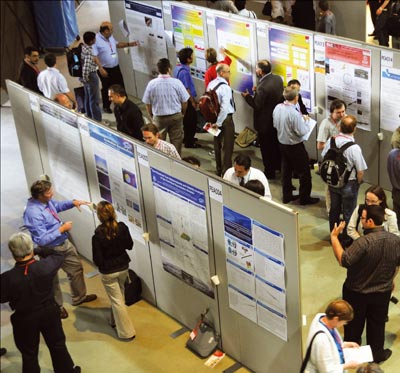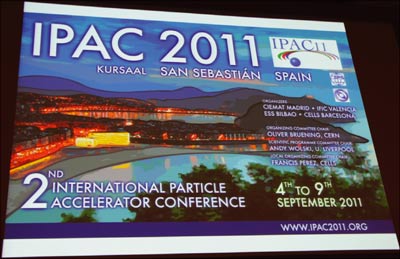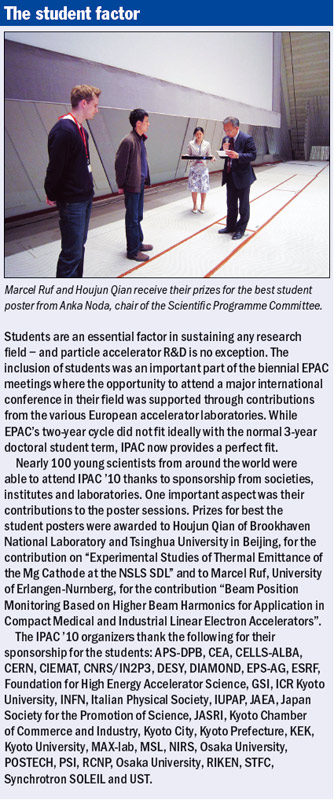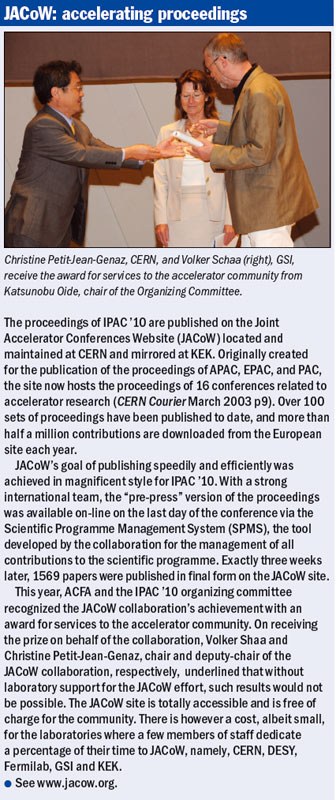A report on the first of the new international series of annual
accelerator conferences.
Résumé
IPAC ’10 : l’accélération à l’échelle internationale
Une nouvelle ère a commencé cette année avec l’inauguration de la Conférence internationale sur les accélérateurs de particules (IPAC), fusionnant les différentes conférences régionales dans le domaine. L’IPAC aura lieu tous les ans alternativement en Amérique, en Asie et en Europe. La première édition (IPAC ’10), qui s’est tenue du 23 au 28 mai au Centre international de conférences de Kyoto, a été vraiment internationale, puisqu’elle a rassemblé près de 1250 participants à plein temps venant de plus de 30 pays différents d’Afrique, des Amériques, d’Australasie et d’Europe. Le démarrage du Grand collisionneur de hadrons, les progrès des collisionneurs électron-positon de luminosité élevée et l’évolution des sources de lumière comptaient parmi les thèmes marquants de la Conférence.

Image credit: IPAC '10.
For many years members of the particle accelerator community have come together on a more or less regional basis to consider progress in their field and present the state of the art. North America has held the Particle Accelerator Conference (PAC) in “odd” years since the 1960s; the European Particle Accelerator Conference (EPAC) has run in “even” years since 1988; and the first Asian Particle Accelerator Conference (APAC) started on a three-year cycle in 1998. Now, as particle accelerators are beginning to exist worldwide, a new era has begun with a merging of the conferences into the International Particle Accelerator Conference (IPAC), which will alternate between America, Asia and Europe on a three-yearly basis.
The first in the series, IPAC ’10, took place at the Kyoto International Conference Centre on 23–28 May. It was an international affair, with close to 1250 full-time participants coming from more than 30 different countries in Africa, Asia, the Americas, Australasia and Europe. The conference was organized by the Science Council of Japan, the Physical Society of Japan, the Particle Accelerator Society of Japan and the Atomic Energy Society of Japan under the auspices of the Asian Committee for Future Accelerators (ACFA), the European Physical Society Accelerator Group, the American Physical Society Division of Physics of Beams and institutes in North America involved in PAC.
Shin-ichi Kurokawa and Katsunobu Oide, respectively honorary chair and chair of the Organizing Committee, Akira Noda, chair of the Scientific Programme Committee (SPC), and Toshiyuki Shirai, chair of the Local Organizing Committee, had the honour of opening the inaugural conference. Then, setting an appropriate international flavour, Albrecht Wagner, previously director of DESY and a former chair of the International Committee for Future Accelerators, opened the scientific programme with a presentation on “International Collaboration with High Energy Accelerators”.
The scientific programme
The programme itself spanned four and a half days, with plenary sessions on Monday and Friday mornings, and on Thursday afternoon. All of the other sessions were composed of two parallel oral sessions, while lively poster sessions took place at the end of each afternoon. The scientific programme was developed by the IPAC ’10 SPC, a truly international body with members composed 50% from Asia and 50% from Europe and North America. All together, there were 54 invited talks, 45 contributed oral presentations and 1800 posters. An industrial exhibition also took place during the first three days of the conference, in which 87 companies presented their hi-tech products and services.
CERN’s LHC had a central role in many of the presentations, both in talks and in posters. This was the first major accelerator conference to follow the machine’s successful restart in November 2009 and hence the first opportunity to present measurements from commissioning with beam. CERN’s Steve Myers set the scene in the opening plenary session, beginning with the repairs and consolidation following the incident that had brought commissioning to an early standstill in September 2008 (The subtle side of superconductivity). Since the end of March the machine has been operating at 7 TeV in the centre of mass, with alternating periods of beam commissioning and physics data-taking. In the first two months, the peak luminosity increased by two orders of magnitude, with a goal of reaching 1032 cm–2 s–1 before the end of 2010. Myers paid tribute to the high quality and reliability of many of the systems, which had made the commissioning fast, as well as to the dedication of the many teams and collaborating institutes that had made it all possible.
Other talks and poster presentations focused on more specific aspects of the LHC. The cryogenic system, for example, is the largest in the world in terms of refrigeration capacity (about 140 kW at 4.5 K and 20 kW at 1.8 K), distributed superfluid helium (24 km of superconducting magnets for a total mass of 36 000 tonnes below 2 K) and cryogen inventory (more than 130 tonnes of helium). The first operating experience with beams has already shown an availability of 90% and the learning process continues as the cryogenics teams resolve how to improve weaker points in the system, reducing both the number of unplanned stops and the recovery time after a stop. The control of the beam optics round all 27 km of each of the two rings and the precise alignment (to a tenth of a millimetre) of each individual element of the machine has been another success story. The optics (determining the beam size at any point of the machine) is based on a calculated magnetic model that provides the expected relationship between current and field in the magnets. The early phase of commissioning immediately showed the high quality of both the optics modelling and the magnetic model, which were based on measurements taken during five years of magnet production and testing. The orbit is within the specifications thanks to the alignment accuracy and its correction has raised no important issues.
Another vitally important aspect of LHC operation is the machine-protection system. Safe operation requires many systems for beam dumping, beam interlocks, beam instrumentation, equipment monitoring, collimators and absorbers, etc. The stored energy in the LHC beams is therefore being increased in steps, with operation for physics in between. At each step the machine protection is validated for operational conditions. By the time of the conference the energy stored in each of the beams already exceeded 100 kJ. By the end of 2010 this energy will have increased up to 30 MJ – well above the stored beam energy at Fermilab’s Tevatron, which amounts to about 1 MJ.
Pushing back the luminosity frontier belongs to the much smaller electron–positron storage rings that form the particle “factories”, in particular for studying the physics of B particles, as at PEP-II at SLAC and KEKB at KEK. Nobel laureate Makoto Kobayashi emphasized the importance of the B factories in establishing the mechanism of CP violation in the six-quark model, for which he and Toshihide Maskawa shared the Nobel prize in 2008 (CERN Courier November 2008 p6). In the following talk, Mika Masuzawa of KEK described how the physics community has now set a target of an integrated luminosity of 50–75 ab–1 for the exploration of new physics beyond the Standard Model. At a luminosity of
2 × 1034 cm–2 s–1 (near the KEKB peak) this would take more than 100 years, so there is a need for machines of much higher luminosity. Two projects that are currently in advanced stages of design, SuperKEKB in Japan and SuperB in Italy, aim to deliver a luminosity some 40–50 times higher (0.8 × 1036 cm–2 s–1 and 1 × 1036 cm–2 s–1 respectively).
Historically, particle accelerators developed as tools for high-energy particle physics and it was these that originally formed the basis for the associated conferences. The past decade, however, has seen an explosion in the number of accelerators used as light sources. There are now some 70 light sources in the world, serving a community of more than 100,000 users. In general, these users are demanding smaller beams and shorter pulses. One result is that light sources are now based not only on electron storage rings, but increasingly on free-electron lasers (FELs). These can provide short pulses of coherent radiation, which are valuable for probing rapidly changing processes.
John Galayda of the SLAC National Accelerator Laboratory presented the field’s equivalent of the LHC – the Linac Coherent Light Source (LCLS), the world’s first X-ray FEL to operate in the photon energy range 820–8200 eV. The LCLS uses an electron beam produced by a 1 km section of SLAC’s famous linac. It produced its first X-ray laser beam on 10 April 2009 and the first run for users took place between October and December 2009. Eleven successful experiments in atomic, molecular and optical science collected some 200 TB of data. Today it is routinely producing X-ray pulses with an energy of a few millijoules across the operating wavelength range.
Femtosecond X-ray pulses at linac-driven FELs such as the LCLS have a great scientific potential. “Pump-probe” experiments at these facilities aim to use X-rays (the probe) to produce time-resolved information at the atomic scale on a sample that has been excited (pumped) with a laser. Studies at the LCLS have already demonstrated an optical timing system based on stabilized fibre links that provide the required synchronization at less than 20 fs.
In Europe, FLASH, the FEL-user facility at DESY, covers a wavelength range of 6.5–50 nm and pulse durations of 10–50 fs. An upgrade started in autumn 2009 to increase the beam energy to 1.2 GeV – and reduce the shortest photon wavelength to 4.5 nm – by installing a seventh superconducting accelerating module, which is also a prototype for the European X-ray FEL project, XFEL.
Globally, there has been continued growth in the number of synchrotron light sources, with new machines coming on line to satisfy the demands of a rapidly expanded user community, particularly in the areas of biology and life sciences. New facilities include PETRA III at DESY, the Shanghai Synchrotron Radiation Facility in China, the Taiwan Photon Source in South-East Asia and the SESAME facility under construction in the Middle East. Older facilities are also responding to increasing demands from the users. In Japan, for example, a team at the Spring-8 storage ring is developing a system to provide short-pulse X-rays using crab cavities to tilt the beam pulses to produce X-ray bunches that are sliced to provide sub-picosecond pulses. A new XFEL machine is also under construction at the Spring-8 laboratory and, in Italy, FERMI@Elettra is a new FEL being built at the home of the Elettra synchrotron-radiation source to supply photons at wavelengths from 100 nm down to 4 nm. In Russia, the Budker Institute of Nuclear Physics in Novosibirsk has begun operating the world’s first multiorbit energy-recovery linac serving two FELs at present (CERN Courier July/August 2010 p10).
Developing applications
Accelerators play a key role not only in research in life sciences, but also in applications in medicine. Accelerator pioneer Robert Wilson first proposed using protons and light ions for cancer therapy more than 60 years ago. Today there are five carbon-ion therapy facilities around the world, with more to come. The Japanese, in particular, are making impressive headway in the field, with more than 10 years of experience at the Heavy-Ion Medical Accelerator in Chiba (HIMAC), where a new treatment facility is being constructed (CERN Courier June 2010 p22). The IPAC conference followed a week after a meeting of the Particle Therapy Co-Operative Group in Chiba.
Other developing areas for the application of particle accelerators figured in the closing plenary sessions, with talks from Norbert Holtkamp, principal deputy director-general of ITER, on energy-related developments, and by Jasper Kirkby of CERN, on the use of particle beams in climate research. Finally, Johannes Bluemer, of the Karlsruhe Institute of Technology, brought a different perspective, when he looked to the most powerful accelerators – those that exist in nature, providing cosmic rays with energies up to 100 EeV. These energies – and the multikilometre scale of the Pierre Auger Project to study these ultrahigh-energy cosmic rays – extend even further the superlatives reached by the LHC.
In addition to the standard sessions, the conference provided the opportunity to present a number of prizes. ACFA and IPAC together awarded prizes for outstanding work in the field of accelerators to Steve Myers of CERN, Jie Wei of Tsinghua University, and Mei Bai of Brookhaven National Laboratory (CERN Courier March 2010 p30). There were also prizes for the best student posters (The student factor). A further prize, decided by the IPAC ’10 organizing committee, was presented to the JACoW collaboration for its service to the accelerator community (JACoW: accelerating proceedings). Lastly, Caterina Biscari of INFN-LNF received a plaque on behalf of her colleague Claudio Federici, who won the competition to design a logo for the new IPAC series.

The first conference in the new international series has thus set the scene for the future meetings. The second IPAC will take place in San Sebastián, Spain (September 2011), and the third in New Orleans, in the US (May 2012). In this way the collaboration between the three regions, steadily enhanced in recent years, should continue to grow to the benefit of the worldwide accelerator community.
The student factor

Students are an essential factor in sustaining any research field – and particle accelerator R&D is no exception. The inclusion of students was an important part of the biennial EPAC meetings where the opportunity to attend a major international conference in their field was supported through contributions from the various European accelerator laboratories. While EPAC’s two-year cycle did not fit ideally with the normal 3-year doctoral student term, IPAC now provides a perfect fit.
Nearly 100 young scientists from around the world were able to attend IPAC ’10 thanks to sponsorship from societies, institutes and laboratories. One important aspect was their contributions to the poster sessions. Prizes for best the student posters were awarded to Houjun Qian of Brookhaven National Laboratory and Tsinghua University in Beijing, for the contribution on “Experimental Studies of Thermal Emittance of the Mg Cathode at the NSLS SDL” and to Marcel Ruf, University of Erlangen-Nurnberg, for the contribution “Beam Position Monitoring Based on Higher Beam Harmonics for Application in Compact Medical and Industrial Linear Electron Accelerators”.
The IPAC ’10 organizers thank the following for their sponsorship for the students: APS-DPB, CEA, CELLS-ALBA, CERN, CIEMAT, CNRS/IN2P3, DESY, DIAMOND, EPS-AG, ESRF, Foundation for High Energy Accelerator Science, GSI, ICR Kyoto University, INFN, Italian Physical Society, IUPAP, JAEA, Japan Society for the Promotion of Science, JASRI, Kyoto Chamber of Commerce and Industry, Kyoto City, Kyoto Prefecture, KEK, Kyoto University, MAX-lab, MSL, NIRS, Osaka University, POSTECH, PSI, RCNP, Osaka University, RIKEN, STFC, Synchrotron SOLEIL and UST.
JACoW: accelerating proceedings

The proceedings of IPAC ’10 are published on the Joint Accelerator Conferences Website (JACoW) located and maintained at CERN and mirrored at KEK. Originally created for the publication of the proceedings of APAC, EPAC, and PAC, the site now hosts the proceedings of 16 conferences related to accelerator research (CERN Courier March 2003 p9). Over 100 sets of proceedings have been published to date, and more than half a million contributions are downloaded from the European site each year.
JACoW’s goal of publishing speedily and efficiently was achieved in magnificent style for IPAC ’10. With a strong international team, the “pre-press” version of the proceedings was available on-line on the last day of the conference via the Scientific Programme Management System (SPMS), the tool developed by the collaboration for the management of all contributions to the scientific programme. Exactly three weeks later, 1569 papers were published in final form on the JACoW site.
This year, ACFA and the IPAC ’10 organizing committee recognized the JACoW collaboration’s achievement with an award for services to the accelerator community. On receiving the prize on behalf of the collaboration, Volker Shaa and Christine Petit-Jean-Genaz, chair and deputy-chair of the JACoW collaboration, respectively, underlined that without laboratory support for the JACoW effort, such results would not be possible. The JACoW site is totally accessible and is free of charge for the community. There is however a cost, albeit small, for the laboratories where a few members of staff dedicate a percentage of their time to JACoW, namely, CERN, DESY, Fermilab, GSI and KEK.
• See www.jacow.org.





